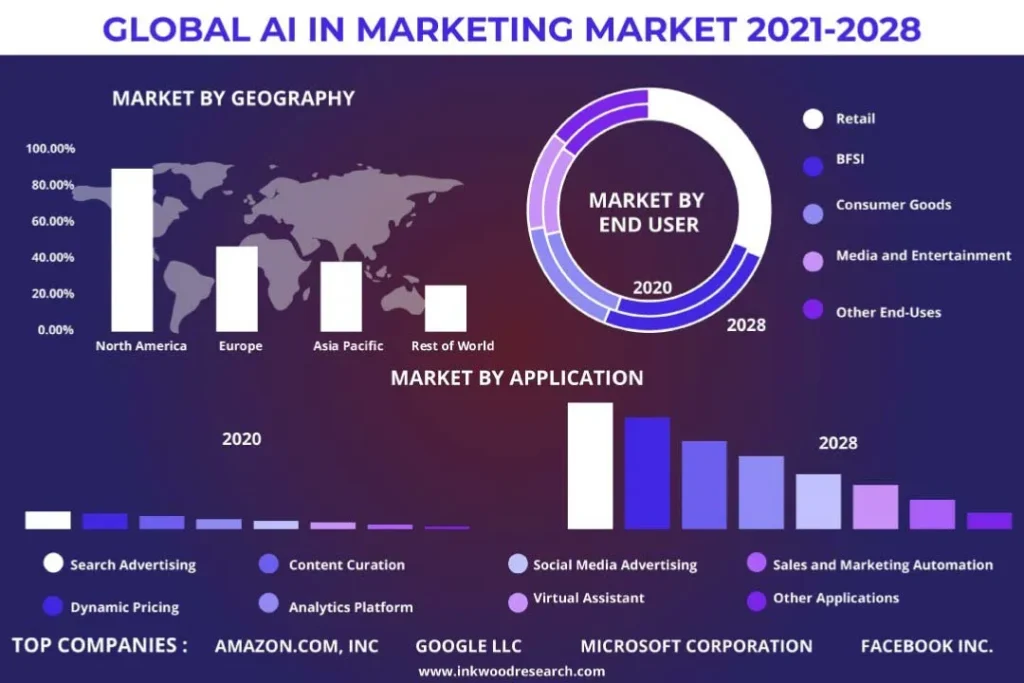Digital marketing current trends is constantly evolving, driven by rapid technological advancements and changing consumer behaviors. In today’s competitive landscape, staying updated with the latest trends is essential for businesses to stay relevant and achieve their goals. This blog explores the current trends in digital marketing that are shaping the industry and helping brands connect more effectively with their audiences.
Table of Contents
Different Digital marketing Current trends
1. Artificial Intelligence (AI) in Marketing
In Digital marketing Current trends artificial intelligence has revolutionized digital marketing by enabling businesses to analyze vast amounts of data, automate processes, and deliver personalized experiences. AI-powered tools are being used for customer segmentation, predictive analytics, and dynamic content creation. Chatbots powered by AI provide real-time customer support, enhancing user satisfaction while reducing operational costs. Additionally, AI is driving advancements in programmatic advertising, ensuring that ads are displayed to the right audience at the right time.
Example: Amazon’s recommendation engine uses AI to analyze user behavior and suggest products, significantly boosting sales.

2. Short-Form Video Content
Digital Marketing Current Trends, short-form video content has become a dominant force in digital marketing. Platforms like TikTok, Instagram Reels, and YouTube Shorts have skyrocketed in popularity, capturing the attention of millions of users. These videos are designed to be engaging and easily consumable, making them an ideal format for brands to convey their message quickly.
Marketers are leveraging this trend to showcase products, share tips, and build a stronger connection with their audience. The key to success lies in creativity and authenticity, as users value content that feels relatable and genuine.
Tip: Brands can use tools like Canva and InShot to create eye-catching short videos with minimal effort.
3. Voice Search Optimization
In Digital Marketing Current Trends with the proliferation of voice assistants like Siri, Alexa, and Google Assistant, optimizing content for voice search has become crucial. Voice searches often differ from text searches, as they tend to be more conversational and question-based. Marketers are now focusing on long-tail keywords and creating content that directly answers users’ queries to align with this growing trend.
To succeed in voice search optimization, businesses should ensure that their website is mobile-friendly, uses natural language in its content, and prioritizes local SEO.
Fun Fact: By 2025, it is estimated that over 75% of households in the US will own a smart speaker.
4. Personalization and Data-Driven Marketing
Personalization is no longer a luxury;in Digital marketing Current trends it’s a necessity. Consumers expect tailored experiences that cater to their individual preferences. Using data-driven insights, businesses can segment their audience and deliver personalized messages through email, social media, and other channels.
For instance, e-commerce platforms often use purchase history and browsing behavior to recommend products. Similarly, personalized email campaigns have been shown to achieve higher open and click-through rates compared to generic ones.
Insight: Tools like HubSpot and Salesforce make it easier for marketers to track user behavior and create targeted campaigns.
5. Sustainability and Purpose-Driven Marketing
In Digital Marketing Current Trends today’s consumers are more conscious about the social and environmental impact of their purchasing decisions. Brands that prioritize sustainability and align with purpose-driven causes are resonating with audiences. Marketing campaigns that highlight eco-friendly practices, ethical sourcing, and community involvement are gaining traction.
For example, Patagonia’s commitment to environmental conservation has helped the brand build a loyal customer base. By communicating their values effectively, businesses can strengthen their brand identity and build trust with consumers.
6. Social Commerce
In Digital Marketing Current Trends Social media platforms have evolved beyond being just tools for engagement; they’ve become full-fledged shopping destinations. Features like Instagram Shops, Facebook Marketplace, and TikTok Shopping allow users to discover and purchase products directly within the app. This seamless integration of social media and e-commerce is redefining the online shopping experience.
To succeed in social commerce, businesses need to focus on high-quality visuals, user-generated content, and influencer partnerships. Interactive features like live shopping events also provide an opportunity to showcase products and engage with customers in real-time.
Tip: Encourage customers to leave reviews and share their experiences on social media to build credibility.
7. Privacy-First Marketing
In Digital Marketing Current Trends as data privacy regulations become stricter, marketers are adapting their strategies to maintain compliance while still delivering effective campaigns. The phase-out of third-party cookies has led to a greater emphasis on first-party data collection. Businesses are investing in ethical data practices, transparent communication, and alternative tracking methods like contextual advertising.
Building trust with customers by being transparent about data usage is essential. Offering value in exchange for data, such as personalized discounts or exclusive content, can also encourage users to share their information willingly.
Key Stat: Google plans to eliminate third-party cookies in Chrome by 2024, impacting a significant portion of digital advertising.
8. Influencer Marketing Evolution
In Digital Marketing Current Trends influencer marketing continues to thrive, but the focus has shifted towards authenticity and micro-influencers. Micro-influencers, who typically have smaller but highly engaged audiences, are proving to be more effective for niche markets. Collaborating with influencers who genuinely align with a brand’s values creates a sense of trust and credibility.
Platforms like TikTok have also democratized influencer marketing, allowing smaller creators to gain visibility and partner with brands. The key is to choose influencers whose content resonates with the target audience.
9. Augmented Reality (AR) and Virtual Reality (VR)
In Digital Marketing Current Trends AR and VR technologies are revolutionizing the way consumers interact with brands. From virtual try-ons for fashion and beauty products to immersive VR experiences, these tools offer unique opportunities for engagement. Social media platforms like Instagram and Snapchat have popularized AR filters, making them a fun and interactive marketing tool.
Brands are also exploring VR for virtual tours, product demonstrations, and immersive storytelling. As technology becomes more accessible, AR and VR are expected to play an even larger role in digital marketing.
10. The Rise of Web3 and Blockchain in Marketing
Web3 technologies, including blockchain, decentralized platforms, and NFTs (non-fungible tokens), are reshaping digital marketing current trends. Blockchain’s transparency and security features are being used for verifying ad metrics, combating ad fraud, and building consumer trust.
NFTs have opened new possibilities for brand engagement, allowing businesses to offer exclusive digital assets and build loyalty programs. While still in its early stages, Web3 presents exciting opportunities for marketers willing to innovate.
Example: Coca-Cola’s NFT campaign offered unique digital collectibles, creating buzz and engaging their audience in a new way.
Conclusion
The digital marketing current trends landscape is dynamic and constantly evolving. Staying updated with these trends is not just about adopting new technologies; it’s about understanding consumer behavior and delivering value. Businesses that embrace these current trends in digital marketing will be better equipped to connect with their audience, build trust, and achieve sustainable growth.
By focusing on personalization, leveraging emerging technologies, and aligning with consumer values, marketers can navigate the ever-changing digital world and drive meaningful results. The future of digital marketing is exciting, and those who adapt will thrive.
Let’s turn your vision into reality with the latest digital marketing trends. Whether it’s SEO, social media, or AI-driven strategies, we’re here to help.
FAQ on Digital marketing Current trends
1. What are the key trends in digital marketing today?
The key trends in digital marketing include:
- Artificial Intelligence (AI) for personalization and automation.
- Short-form video content on platforms like TikTok and Instagram Reels.
- Voice search optimization for smart devices.
- Social commerce integration for seamless shopping experiences.
- Emphasis on privacy-first marketing and ethical data collection.
2. How is artificial intelligence transforming digital marketing?
AI is revolutionizing digital marketing by:
- Enhancing customer segmentation and personalization.
- Automating tasks such as email campaigns and chatbots.
- Providing insights through predictive analytics.
- Enabling programmatic advertising for targeted ad placements.
3. Why is short-form video content so popular in digital marketing?
Short-form videos are engaging, easy to consume, and highly shareable, making them ideal for modern audiences with limited attention spans. Platforms like TikTok and YouTube Shorts amplify their reach, allowing brands to showcase products creatively and connect with younger demographics.
4. What role does social commerce play in current marketing strategies?
Social commerce integrates e-commerce features within social media platforms, enabling users to discover, browse, and purchase products without leaving the app. This trend streamlines the shopping experience and helps brands directly target their audience through engaging content and influencer collaborations.
5. How is data privacy impacting digital marketing trends?
Data privacy regulations, like GDPR and CCPA, are reshaping digital marketing by:
- Limiting the use of third-party cookies.
- Encouraging first-party data collection.
- Promoting transparency in data usage.
Marketers are adopting privacy-first strategies to maintain consumer trust while delivering personalized experiences.
